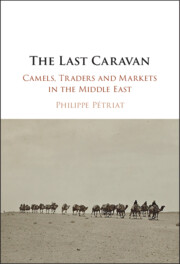
-
Select format
-
- Publisher:
- Cambridge University Press
- Publication date:
- January 2025
- January 2025
- ISBN:
- 9781009524537
- 9781009524520
- Dimensions:
- (229 x 152 mm)
- Weight & Pages:
- 0.6kg, 306 Pages
- Dimensions:
- Weight & Pages:
You may already have access via personal or institutional login
Book description
What can travelling camels tell us about the history of the interior of the Middle East? In this innovative book Philippe Pétriat demonstrates how caravans - groups of travellers, often on trade expeditions, journeying together for mutual protection in hostile regions - are essential to understanding the history of the inside territories of the Ottoman Empire with its neighbours. From the first use of camels in transport, through to the decline of the caravan from the 1930s onwards, Pétriat reconstructs the land routes of these travellers through vast steppes and deserts in captivating detail. Moving discussions of the political economy of the Ottoman and post-Ottoman Middle East beyond analysis of the coastal regions and maritime exchanges with Western countries, The Last Caravan instead reveals the pivotal importance of the Ottoman and Arab merchants in the suburbs of the cities and the rural markets and the travelling nomads and the animals that supported them.
Reviews
‘Pétriat has blasted open the gates of Arabian Peninsula history. He tracks people and processes that have fallen between the cracks of national paradigms, inviting us to rethink transitions to the time of capitalism, the automobile, and the nation-state. With this book, Pétriat has rewritten the story of modern Arabia.’
Fahad Ahmad Bishara - University of Virginia
‘Philippe Pétriat has written a brilliant and far-reaching history, of trade, traders, and trading culture in the Ottoman and post-Ottoman Arab East. Pétriat introduces readers to a lost and forgotten world of vital land trade. As he notes, it was a world so commonplace and central to the Middle East and its peoples, it escaped mention until it disappeared. Thanks to Philippe Pétriat, the world of the traders comes back to life for readers today.’
Michael Provence - University of California San Diego
‘An indispensable contribution to the connected history of traders and markets and to the Middle East’s political economy, offering a master class in writing history while filling a significant gap in the scholarship … Recommended.’
K. Mouradian Source: Choice
Contents
Metrics
Altmetric attention score
Full text views
Full text views help Loading metrics...
Loading metrics...
* Views captured on Cambridge Core between #date#. This data will be updated every 24 hours.
Usage data cannot currently be displayed.
Accessibility standard: Unknown
Why this information is here
This section outlines the accessibility features of this content - including support for screen readers, full keyboard navigation and high-contrast display options. This may not be relevant for you.
Accessibility Information
Accessibility compliance for the PDF of this book is currently unknown and may be updated in the future.

